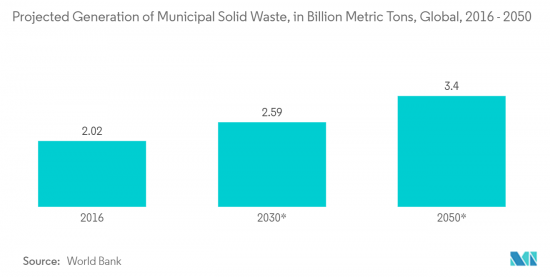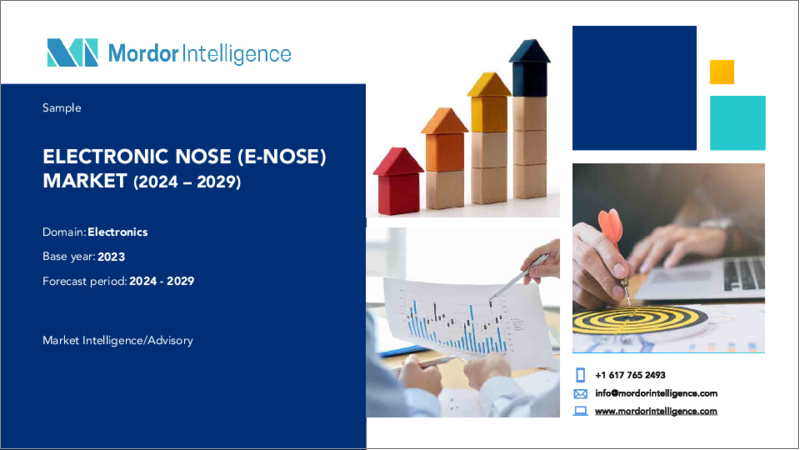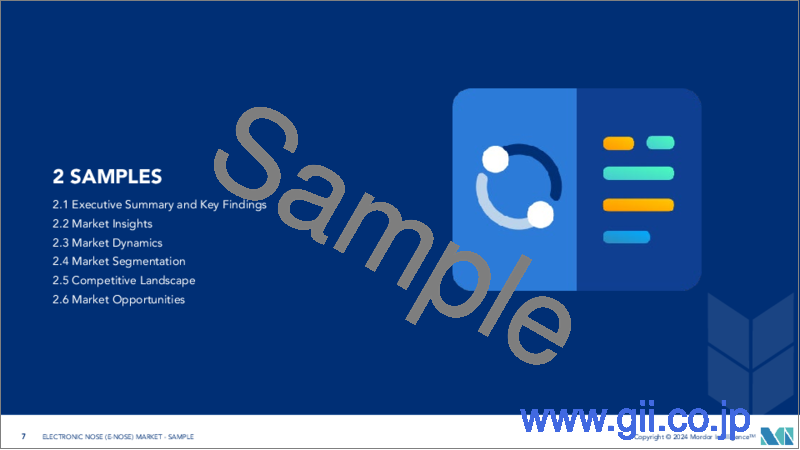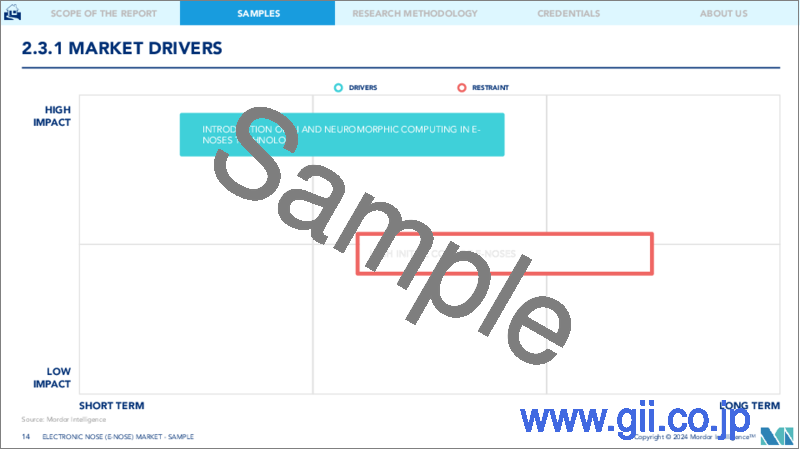|
|
市場調査レポート
商品コード
1404504
電子鼻(E-Nose):市場シェア分析、産業動向・統計、2024~2029年の成長予測Electronic Nose (E-Nose) - Market Share Analysis, Industry Trends & Statistics, Growth Forecasts 2024 - 2029 |
||||||
|
● お客様のご希望に応じて、既存データの加工や未掲載情報(例:国別セグメント)の追加などの対応が可能です。 詳細はお問い合わせください。 |
|||||||
| 電子鼻(E-Nose):市場シェア分析、産業動向・統計、2024~2029年の成長予測 |
|
出版日: 2024年01月04日
発行: Mordor Intelligence
ページ情報: 英文 113 Pages
納期: 2~3営業日
|
- 全表示
- 概要
- 目次
電子鼻(E-Nose)の市場規模は2024年に2,738万米ドルと推定され、2029年には5,310万米ドルに達すると予測され、予測期間中(2024~2029年)のCAGRは14.17%で成長します。

主要ハイライト
- 人工知能(AI)、クラウド、モノのインターネット(IoT)などの技術の進歩は、電子鼻(E-Nose)技術の需要にプラスの影響を与えています。これらの進歩により、電子鼻(E-Nose)業界の製品の主要コンポーネントの1つであるコンピューティングシステムが強化されています。
- 電子鼻(E-Nose)は、ワイン、野菜、タバコのような品目の臭いを識別する上で重要な応用価値を持つ。臭いの検出、原材料の検査、品質表示、散水工程管理などに広く採用されています。また、品質保証や品質管理に欠かせないツールのひとつでもあります。果物や野菜の検査では、主に成熟度の検出や種の識別に使用されます。
- 肺がん、結核、糖尿病のような疾病の有病率の増加と、これらの疾病の早期発見の必要性の増加が、調査した市場の成長に重要な役割を果たしています。米国がん協会によると、2023年には米国で約5万9,910人の女性が肺がんと気管支がんで死亡すると推定されています。2023年に米国で肺がん・気管支がんで死亡する男性は8万8,900人と推定されています。
- 電子鼻(E-Nose)市場は、犯罪・セキュリティ分野からの需要も目の当たりにしています。国際テロの急増とテロ攻撃における爆発物の使用の増加に伴い、法執行機関は世界的に、荷物、郵便物、車両、航空機に隠された爆弾を検出するという問題に直面しています。軍事・防衛分野では、爆発物、化学剤、その他の危険物の検知にE-Noseが使用されています。また、軍事施設や訓練場での監視、偵察、環境モニタリングにも使用されています。
- 電子鼻(E-Nose)に組み込まれるセンサーのコストが高いため、電子鼻(E-Nose)のコストは著しく高いです。これは、電子鼻(E-Nose)の初期コストが高く、中小企業には手が出ないため、市場の成長を妨げる大きな要因となっています。ユーザー間の認識や技術的専門知識の不足は、さまざまな地域によって規制要件が異なることと相まって、調査した市場の成長を妨げるもう1つの要因となっています。
- COVID-19の流行とともに、世界の経済状況、防衛に対する政府の支出、地政学的緊張、技術の進歩など、さまざまなマクロ経済動向が防衛分野に影響を与えています。現在、防衛分野を形成している世界のマクロ経済動向には、脱炭素化、高強度戦争(HIW)、環境・社会・ガバナンス(ESG)への配慮、防衛分野への世界の投資拡大などがあります。SIPRIによると、2022年の軍事費に8,770億米ドルが割り当てられ、米国は軍事費が最も多い国のランキングでトップに立っています。これは同年の世界の軍事費全体(総額2兆2,000億米ドル)の約40%に相当します。推定2,920億米ドルを費やした中国は2番目に軍事費が多く、ロシアが3位だった。
- 米国議会予算局によると、米国の国防費は2033年まで毎年増加すると予測されています。米国の国防費は2023年には7,460億米ドルに達します。同予測では、2033年には国防費が1兆1,000億米ドルまで増加すると予測されています。このような動きは、軍事・防衛分野における電子鼻(E-Nose)のような先進技術の採用を後押しする可能性が高いです。
電子鼻(E-Nose)市場の動向
廃棄物管理(環境モニタリング)が最大のエンドユーザー分野に
- 埋立地で発生するメタンガスやその他の悪臭は、地球温暖化の原因となるだけでなく、悪臭による迷惑行為も引き起こし、さまざまな地域で最大の迷惑行為の原因のひとつとされています。その結果、廃棄物管理や環境影響モニタリング用途は、電子鼻(E-Nose)技術に大きな可能性をもたらしています。
- 特に拡散モデリングが適用できないケースでは、臭気暴露評価目的のE-Noseの機会は極めて重要です。たとえば埋立地では、発生源の性質などの理由から、シミュレーション時間領域ごとに臭気排出の詳細な特性評価と定量化が困難であるため、レセプターを使用するE-Nose技術が大きな可能性を持つ。各地域の政府が、埋立地をよりよく管理するために循環型経済(リサイクルによる再利用)を検討しているため、このようなリアルタイム監視を可能にする技術の必要性が高まっています。
- 廃水処理施設(WWTP)からの産業ガス排出による悪臭迷惑は、その場でリアルタイムに悪臭濃度を正確に定量化する適切な計測器がないこともあり、適切な管理が難しい繰り返し起こる問題です。このような測定は、臭気軽減システムの効率を定期的に検証し、プラント内の主要臭気発生源を特定し、大気拡散モデルに基づいて場外への影響を予測するための鍵となります。
- 臭気をもっぱら嗅覚測定法(人体パネル)で測定する場合、この技術の高コストと不連続な性質により、臭気排出の代表的な特徴を提供するには測定回数がどうしても不足してしまいます。電子鼻(E-Nose)は現在、環境臭気モニタリングの最も有望なツールのひとつと考えられています。
- 廃棄物の発生率は世界中で上昇しています。世界銀行によると、2020年には世界で22億4,000万トンの固形廃棄物が発生し、これは1人1日あたり0.79kgのフットプリントに相当します。都市化に伴う急速な人口増加に伴い、年間廃棄物発生量は2020年比で73%増加し、2050年には38億8,000万トンに達すると推定されています。廃棄物量の増加に伴い、廃棄物管理のための新技術への投資と採用が、予測期間中にE-Noseの採用を積極的に後押しし、影響を与えると予想されます。

北米がEノーズ市場を独占する
- 北米が市場で大きなシェアを占めているのは、インフラが発達していることや資源が入手しやすいことなどの要因によるもので、防衛、医療、飲食品などの分野でE-Nose技術の採用が進んでいます。
- この地域はまた、規制の厳しい主要な飲食品産業の本拠地でもあります。そこで、E-Nose技術は成長の絶好の機会を見出しています。例えば、米国国勢調査局によると、2022年12月の米国における飲食品店の月間小売売上高は884億3,000万米ドルであったのに対し、2022年11月は821億4,000万米ドルでした。
- StatCanによると、カナダにおける飲食料品店の小売売上高は、2021年6月の118億1,000万カナダドル(87億3,000万米ドル)に対し、2022年6月は120億6,000万カナダドル(89億1,000万米ドル)でした。このような飲食品販売の増加は、予測期間中の電子鼻(E-Nose)装置の需要を促進する可能性があります。
- 電子鼻(E-Nose)技術は、肉や鶏肉製品などの食品の鮮度を人間の鼻よりも効果的に検出できるため、飲食品業界では需要が高いです。これは食品の日持ちを正確に判断し、食品廃棄量を減らすのに役立ちます。
- 同様に、米国の医療機関では、E-Nose技術を使って子供の喘息を診断しようとしています。米国だけでも、約620万人の子供が喘息と診断されており、18歳以下の人口の8.4%を占めています。Pediatric Pulmonologyが発表した報告書によると、同国ではE-Nose技術を用いた喘息診断の成功率は80~100%でした。同調査は、この技術には欠点が少なく、今後数年で克服される見込みであり、この技術の普及に道を開くと述べています。
- また、この地域の都市や州は、臭気公害について市民や企業を規制しているため、E-Noseソリューションが発展する可能性があります。例えば、テキサス州ブダでは、悪臭に対して住民に罰金を課しています。これには、煙、化学物質、動物の死体などの悪臭を宣言する条例が含まれます。さまざまなエンドユーザー産業で進行中の同様の技術革新と研究が、この地域での市場成長の触媒として作用すると予想されます。
電子鼻(E-Nose)産業概要
電子鼻(E-Nose)市場は、Alpha MOS、Plasmion GmbH、The eNose Company、Airsense Analytics GmbH、Envirosuiteなど複数の企業が存在し、半固体化しています。市場の各社は、消費者の複雑で進化するニーズに応えるため、先進的な製品やプロセスを開発し、サプライチェーンを強化することを目指しています。
- 2023年5月、Alpha MOSは、世界第7位、中国第1位の酪農グループである中国のコングロマリットMengniuによる、同社の乳質管理ソリューションの正式な検証を宣言しました。この認証は、Mengniu社にHeracles NEO電子鼻(E-Nose)を装備することを目的とした、流通企業Lan Chou Instrumentsとの2年間の枠組み契約の締結から6ヶ月後に付与されました。Heracles NEOを3台導入した最初のメーカーとなり、製品の香りの経時変化を運転条件下でモニターできるようになった。
- 2023年4月、The eNose Companyは、シカゴで開催されたHIMSS Global Health Conference and Exhibitionで、肺がん治療にaeoNoseを使用するデモンストレーションを行った。aeoNoseは同社のプラットフォームIRIS4health Intersystemsを使用してEHRと通信します。
その他の特典:
- エクセル形式の市場予測(ME)シート
- 3ヶ月間のアナリストサポート
目次
第1章 イントロダクション
- 調査の前提条件と市場定義
- 調査範囲
第2章 調査手法
第3章 エグゼクティブサマリー
第4章 市場洞察
- 市場概要
- 業界の魅力度-ポーターのファイブフォース分析
- 供給企業の交渉力
- 買い手/消費者の交渉力
- 新規参入業者の脅威
- 代替品の脅威
- 競争企業間の敵対関係
- COVID-19の電子鼻(E-Nose)市場への影響
第5章 市場力学
- 市場促進要因
- 電子鼻(E-Nose)技術におけるAIとニューロモーフィック・コンピューティングの導入
- 市場の課題
- 電子鼻(E-Nose)の初期コストの高さ
第6章 市場セグメンテーション
- エンドユーザー業界別
- 軍事・防衛
- 医療
- 飲食品
- 廃棄物管理(環境モニタリング)
- その他のエンドユーザー業界別
- 地域別
- 北米
- 欧州
- アジア太平洋
- その他
第7章 競合情勢
- 企業プロファイル
- Alpha MOS
- Electronic Sensor Technology
- Plasmion GmbH
- Envirosuite
- The eNose Company
- Airsense Analytics GmbH
- Sensigent LLC
- Aryballe Technologies SAS
- Stratuscent Inc.
- Common Invent B.V.
- E-Nose Pty Ltd
第8章 投資分析
第9章 市場の将来

The Electronic Nose Market size is estimated at USD 27.38 million in 2024, and is expected to reach USD 53.10 million by 2029, growing at a CAGR of 14.17% during the forecast period (2024-2029).
Key Highlights
- Technological advances, such as artificial intelligence (AI), the cloud, and the Internet of Things (IoT), have positively impacted the demand for electronic nose technology. These advancements have enhanced computing systems, which are one of the key components of products in the electronic nose industry.
- The electronic nose has significant application value in identifying odors of items like wine, vegetables, or cigarettes. It is widely employed in odor detection, raw material inspection, quality signing, and sprinkling process management. It is also one of the indispensable tools for quality assurance and quality control. It is primarily used for maturity detection and species identification in fruit and vegetable testing.
- The increasing prevalence of diseases like lung cancer, tuberculosis, and diabetes and the increasing necessity for early detection of these diseases play a significant role in the growth of the market studied. According to the American Cancer Society, in 2023, it was estimated that around 59,910 women in the United States would die of lung and bronchial cancer. 88,900 men are estimated to die of lung and bronchial cancer in the United States in 2023.
- The e-nose market is also witnessing demand from the crime and security sector. With the surge of international terrorism and the increased use of explosives in terrorist attacks, law enforcement agencies globally face the problem of detecting hidden bombs in luggage, mail, vehicles, and aircraft. In the military and defense sector, e-nose devices can be used to detect explosives, chemical agents, and other hazardous materials. They are also employed for surveillance, reconnaissance purposes, and environmental monitoring at military installations and training areas.
- The cost of an electronic nose is significantly high due to the high costs of sensors that are incorporated into it. This is a major factor hampering the market's growth as the initial cost of the electronic nose is high, making it unaffordable for small- and medium-sized enterprises. Lack of awareness and technical expertise among users, coupled with varying regulatory requirements across various regions, is another factor that is likely to hinder the growth of the market studied.
- Along with the COVID-19 pandemic, various macroeconomic trends, such as global economic conditions, government spending on defense, geopolitical tensions, and technological advancements, influence the defense sector. Critical macroeconomic trends currently shaping the defense sector include decarbonization, high-intensity warfare (HIW), environmental, social, and governance (ESG) considerations, and increasing investments in the defense sector globally. According to SIPRI, with USD 877 billion allocated to the military in 2022, the United States leads the ranking of countries with the largest military spending. That equated to approximately 40% of overall global military spending that year, which totaled USD 2.2 trillion. With an estimated USD 292 billion spent, China was the second-highest military spender, with Russia coming in third.
- According to the US Congressional Budget Office, defense spending in the United States is predicted to increase every year until 2033. Defense outlays in the United States amount to USD 746 billion in 2023. The forecast predicts an increase in defense outlays up to USD 1.1 trillion in 2033. Such developments are likely to boost the adoption of advanced technologies like electronic nose in the military and defense sector.
Electronic Nose Market Trends
Waste Management (Environmental Monitoring) to be the Largest End-user Vertical
- Methane gas and other odors produced at landfills not only contribute to global warming but also create an odor nuisance, which is considered one of the largest sources of nuisance in various regions. As a result, waste management or environmental impact monitoring applications provide significant scope for electronic nose technology.
- The opportunities for e-nose for odor exposure assessment purposes are critical, especially in cases where dispersion modeling is not applicable. For instance, in landfills, where a detailed characterization and quantification of odor emissions for every hour of the simulation time domain is difficult due to the nature of the source, among other reasons, e-nose technology that uses receptors can be of strong potential. As governments across regions are considering a circular economy (reuse by recycling) to manage their landfills better, the need for such technology that enables real-time monitoring is increasing.
- Odor annoyance due to industrial gas emissions from wastewater treatment plants (WWTPs) is a recurring problem that is difficult to manage properly, partly due to the lack of appropriate instrumentation to accurately quantify odor concentrations in situ and in real-time. Such measurements are key to regularly verifying the efficiency of odor abatement systems, identifying the main odor sources within the plant, and predicting off-site impacts based on atmospheric dispersion models.
- When odors are exclusively measured by olfactometry (human panels), the high cost and discontinuous nature of this technique inevitably lead to an insufficient number of measurements to provide a representative characterization of the odor emissions. Electronic noses are currently considered one of the most promising tools for environmental odor monitoring.
- Waste generation rates are rising around the world. As per the World Bank, in 2020, the world generated 2.24 billion tons of solid waste, which amounted to a footprint of 0.79 kg per person per day. With rapid population growth along with urbanization, annual waste generation is estimated to increase by 73% from 2020 levels to reach 3.88 billion tons in 2050. With the growing amount of waste, the investment and adoption of new technologies in managing waste are expected to positively boost and influence e-nose's adoption during the forecast period.

North America to Dominate the E-Nose Market
- North America holds a significant share of the market studied due to factors such as developed infrastructure and the availability of resources, which have enabled the adoption of e-nose technology in sectors such as defense, healthcare, and food and beverages, among others.
- The region is also home to a major food and beverage industry, which is highly regulated. This is where e-nose technology finds a prime opportunity for growth. For instance, according to the US Census Bureau, in December 2022, the monthly retail sales of food and beverage stores in the United States were USD 88.43 billion, compared to USD 82.14 billion in November 2022.
- According to StatCan, retail sales of food and beverage stores in Canada amounted to CAD 12.06 billion (USD 8.91 billion) in June 2022, compared to CAD 11.81 billion (USD 8.73 billion) in June 2021. Such an increase in food and beverage sales may facilitate the demand for electronic nose devices during the forecast period.
- The demand for e-nose technology is high in the food and beverage industry, as it can detect the freshness of food items, such as meat and poultry products, more effectively than a human nose. This helps in accurately determining the longevity of food items and reducing the amount of food waste.
- Similarly, healthcare agencies in the United States are trying to diagnose asthma in children using e-nose technology. In the United States alone, about 6.2 million children are diagnosed with asthma, comprising 8.4% of the population younger than 18 years. According to the report published by Pediatric Pulmonology, the country achieved an 80-100% success rate in asthma diagnosis using the e-nose technology. The study stated that this technology has fewer drawbacks, which are expected to be combated in the coming years, paving the way for the widespread adoption of this technology.
- Also, cities and states in the region regulate citizens and enterprises for odor pollution, which allows e-nose solutions to grow. For example, Buda, Texas, is fining residents for offensive odors. This includes an ordinance declaring offensive odors, including smoke, chemicals, and dead animals. Similar ongoing innovations and research across various end-user industries are expected to act as a catalyst for the market's growth in the region.
Electronic Nose Industry Overview
The Electronic Nose Market is semi-consolidated with the presence of several players like Alpha MOS, Plasmion GmbH, The eNose Company, Airsense Analytics GmbH, Envirosuite, etc. The companies in the market aim to develop advanced products and processes and strengthen their supply chains to cater to consumers' complex and evolving needs.
- In May 2023, Alpha MOS declared the formal validation of its milk quality control solution by the Chinese conglomerate Mengniu, which is the seventh-largest dairy group globally and the foremost in China. This validation was granted six months after the execution of a two-year framework agreement with the distribution enterprise Lan Chou Instruments, which aimed at equipping Mengniu with Heracles NEO electronic noses. The manufacturer has become the first to be equipped with three Heracles NEO instruments to monitor, under operational conditions, the alterations in the aroma of its products over time.
- In April 2023, The eNose Company demonstrated the use of the aeoNose to treat lung cancer at the HIMSS Global Health Conference and Exhibition in Chicago. The aeoNose communicates with the EHR using the company's platform, IRIS4health Intersystems.
Additional Benefits:
- The market estimate (ME) sheet in Excel format
- 3 months of analyst support
TABLE OF CONTENTS
1 INTRODUCTION
- 1.1 Study Assumptions and Market Definition
- 1.2 Scope of the Study
2 RESEARCH METHODOLOGY
3 EXECUTIVE SUMMARY
4 MARKET INSIGHTS
- 4.1 Market Overview
- 4.2 Industry Attractiveness - Porter's Five Forces Analysis
- 4.2.1 Bargaining Power of Suppliers
- 4.2.2 Bargaining Power of Buyers/Consumers
- 4.2.3 Threat of New Entrants
- 4.2.4 Threat of Substitutes
- 4.2.5 Intensity of Competitive Rivalry
- 4.3 Impact of COVID-19 on the Electronic Nose Market
5 MARKET DYNAMICS
- 5.1 Market Drivers
- 5.1.1 Introduction of AI and Neuromorphic Computing in E-Noses Technology
- 5.2 Market Challenges
- 5.2.1 High Initial Cost of E-Noses
6 MARKET SEGMENTATION
- 6.1 By End-user Vertical
- 6.1.1 Military and Defense
- 6.1.2 Healthcare
- 6.1.3 Food and Beverage
- 6.1.4 Waste Management (Environmental Monitoring)
- 6.1.5 Other End-user Verticals
- 6.2 By Geography
- 6.2.1 North America
- 6.2.2 Europe
- 6.2.3 Asia Pacific
- 6.2.4 Rest of the World
7 COMPETITIVE LANDSCAPE
- 7.1 Company Profiles*
- 7.1.1 Alpha MOS
- 7.1.2 Electronic Sensor Technology
- 7.1.3 Plasmion GmbH
- 7.1.4 Envirosuite
- 7.1.5 The eNose Company
- 7.1.6 Airsense Analytics GmbH
- 7.1.7 Sensigent LLC
- 7.1.8 Aryballe Technologies SAS
- 7.1.9 Stratuscent Inc.
- 7.1.10 Common Invent B.V.
- 7.1.11 E-Nose Pty Ltd




